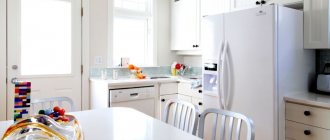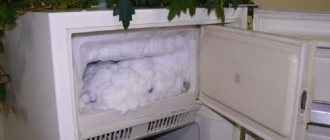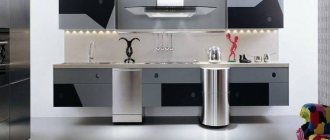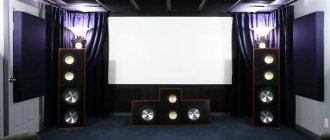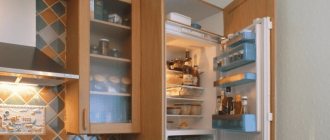Basic rules for choosing a location
For any installation, you need to take into account the features of the room:
- what flooring is in the apartment - quality, material, presence of differences (the latter is relevant for “Khrushchev” buildings),
- is there a dedicated wire from the input electricity meter,
- how far away are sockets, heat and water sources,
- and how the unit will look in the interior with existing furniture.
Let's look at the rules in order.
Floor - durable
Before installing indoors, carefully examine the floors - they must be strong enough and motionless. You cannot install a large-sized refrigerator on a coating that is soft (4-5 layers of linoleum) and springs freely - for example, on boards up to 3 cm thick, located with a large gap. Due to vibration, the motor will hum louder, especially at night, and will soon fail.
If the covering is plank and springy, protect the floor surface with plywood at least 4-5 mm thick.
It is better to install the equipment on concrete - such a floor will withstand even a two-door, two-chamber unit of maximum height. The coating can be finished in any way, but for large equipment a tiled base is more suitable.
Warmth - away
To install a freezer and refrigerator, consider areas of the room far from heat sources. If you do not follow this rule, the unit will quickly fail. The compressor operates constantly, because the device heats up, as a result, the air inside the chamber needs to be cooled regularly. If used for a long time in such conditions, the thermostat fails, and soon the engine fails.
When installing a refrigerator, you should consider the location of the window in the room.
For the same reason, refrigerators and freezers are not placed near windows - in the summer they heat up just like radiators and break down faster. The exception is cases when there is an air conditioner in the room.
It is also impossible to place such equipment next to a gas or electric stove - if the stove is used frequently, it generates a lot of heat.
Minimum distance from heat sources: from the radiator - 30 cm, from the stove - 50 cm.
Sockets - closer
Pay attention to the presence of sockets nearby. The best option is to have a power source near the device.
- Include a direct wire from the electrical panel into the project during the construction phase.
- Buy sockets with grounding (small antennae on the body).
- But even if there is no outlet nearby, do not use multiple extension cords. All the energy from them will accumulate on the first “tee” connected to the plug, the network will be overloaded - and this is a serious risk of fire.
Water is the enemy
Do not install the refrigerator near sinks, taps, washing machines and water pipes: even if they are not close together, splashes will still reach the refrigerator - and you will receive an electric shock from the body. The ideal distance from the water is 2-3 m.
First connection to the power grid
When preparing to turn on the refrigerator for the first time, you should follow some tips:
- Equipment sellers often advise buying a surge protector to protect the unit from voltage surges. But if there is a good outlet in the house with ordinary grounding contacts, such a filter is not necessary. By the way, if you have a regular extension cord at home, you also don’t have to buy a network adapter. Modern extension cords have all grounding contacts, and they cost an order of magnitude cheaper than a filter.
- If, in addition to the refrigerator, you plan to connect several more devices at the same time, then it is better to use network adapters to protect against possible overload; moreover, they are usually equipped with a large number of sockets.
- If the refrigerator was purchased during the cold season, after delivery home it is strictly forbidden to plug it into the network for the first 3-4 hours. During this time, all parts of the device will warm up well, the resulting condensation will evaporate and it can be safely connected to the network.
- When connecting for the first time, it is not recommended to fill the refrigerator with food. You need to give it the opportunity to reach the desired idle temperature. This may take approximately 5 to 10 hours. Only then fill the refrigerator with a small amount of food. The refrigerator should return to normal operation gradually. In a few hours, the unit will be filled with coolness, the freezer will accumulate a sufficient amount of cold, and the refrigeration unit will be able to start working at full capacity.
Modern freezing devices are mostly equipped with computer control; all sensors are very sensitive to various changes and differences, and, accordingly, can fail faster.
On a note. Do not turn off the refrigerator for a period of time less than 1 minute. The compressor may jam and then you won’t be able to do it without a technician!
So how long should a new refrigeration unit run before its first shutdown?
This question is of great concern to owners of both new devices and devices that have recently been repaired or have been turned off for a long period. The fact is that the first time of its operation usually depends on factors such as:
- Room temperature.
- The volume of the refrigerator itself.
- Compressor performance.
- The number of products loaded into it, their temperature.
- Refrigerant type, etc.
On average, this period can be about two hours. If you wish, in order to determine the standard time before the first automatic shutdown of the new refrigerator, it is best to leave it empty, set the temperature thermostat to the minimum position and do not open the door until it is completely turned off. Depending on the above factors, the time can range from 30-40 minutes to 2-3 hours.
Instructions for correct installation
Usually, household appliances come with instructions with detailed rules for transportation, installation, first use and maintenance. If you don't have it at hand, follow the rules:
- If the refrigerator was transported horizontally, wait two to three hours before using it for the first time.
- The recommended distance from the wall to the rear panel of the unit is 10 cm. 5 cm is possible, but air microcirculation will worsen.
- Provide free access - the door should open freely to the maximum angle.
- To prevent slipping, use silicone or plastic stickers on the floor - the unit will make less noise and will not “run” around the kitchen.
- There should be no sofa or kitchen corner near the appliance. If it is not possible to change the layout of the furniture, it is recommended to position the refrigerator so that the distance between it and the interior items is at least 10 cm.
If you follow these rules, the risk of overheating of the mechanism, loss of power, failure of the defrost timer or other components is reduced.
How to move or relocate correctly
The refrigerator can be rolled around the kitchen using a pair of rear wheels. We tilt it back a little and pull the lower part towards us.
Avoid sharp tilts - the device can be dropped onto the floor with its radiator. After such a fall, not all units continue to work; repairs are often required.
Secure the power cord to the grille on the back of the device. If the wire drags along the floor, it is easy to break it, break it, or damage the insulation. For fixation, fasteners are used - plastic clamps.
Electricity and cables
To ensure safe operation of the device, connect it to the electrical panel via a circuit breaker (RCD). Ideally, allocate a separate outlet for the refrigerator. As a last resort, use an extension cord - but only one.
If you cannot connect the unit to a separate outlet, use a surge protector - it will ensure the safety of equipment of any brand (AEG, Beko, Electrolux, LG, Indesit, Samsung, Whirlpool, Bosch, etc.). If there is a voltage drop, the external fuse will burn instead of the delicate electronics.
Alignment by level
Install the refrigerator in the chosen place so that it stands motionless and level, otherwise it will beat, “jump” and “walk” around the kitchen. The fact is that during operation of the compressor the device vibrates, so on an uneven surface it constantly moves. This negatively affects the main nodes.
Adjusting the front legs
Adjust the position of the front legs so that the refrigerator doors close automatically under their own weight. The legs are two plastic washers with bolts located at the bottom front. They allow you to change the angle of inclination of the unit by 1–2 degrees. The magnetic seal will do its job and seal the chamber.
If the floor is flat, without drops (for example, self-leveling or industrial), simply place the equipment in the right place and adjust the position of the front legs. If the floor is uneven, check the slope using a building level.
- Tilt the device back slightly so that your feet are in the air.
- Manually rotate them clockwise (to decrease the height) or counterclockwise to achieve the optimal position.
- Carefully lower the equipment and check the bubble at the construction level.
The final stage
- As a final step, install the shelves in the upper compartment and the drawers in the freezer.
- Change the position of the thermostat by selecting medium temperature mode.
- Perform the first startup of the device, plug the plug into the socket.
How to properly level a refrigerator
To more accurately install the refrigerator in its designated place, use a special device called a level. It is applied to the walls of the device and the legs are twisted so that each side is strictly parallel to the vertical plane. Additionally, to be sure, they also check for horizontal evenness, for which a level is placed on top of the refrigerator.
Reference! It is recommended to twist the front legs a little more, as if tilting the refrigerator back a little. This simple technique guarantees a tighter closure. Adjust the tilt angle by 1-2 degrees.
Features of connecting equipment with an ice maker
Some models of “refrigerated trucks” have an ice maker - a device for creating ice of various shapes and purposes (food, technical). The generator can be a bulk generator - you pour water into a special container yourself - or a stationary one, connected to a water supply.
If you have a tankless generator, carefully align the refrigeration housing relative to the horizon - misalignment will lead to liquid spills and other problems. Stationary requires connection to a power source and water supply.
There are large two-door refrigerators with a No Frost system and an ice maker - they are connected according to the standard scheme. Do not forget that such units should be located far from the heat source.
How to put a microwave on top and is it worth it?
In small apartments, a microwave oven is often placed on top of the refrigerator. This makes sense if the unit is small and you will only heat and defrost food in the oven. Other microwave functions—long cooking, grilling, multicooking, and others—will quickly lead to overheating of the device.
Consider other rules:
- the distance from the wall to the microwave is the same as that of the refrigerator: 10–15 cm;
- Lay plywood or plexiglass between electrical appliances. Film, oilcloth and other flammable materials - under no circumstances;
- The microwave should be equipped with legs so that the gap between the units helps to increase air circulation.
Place for installing a refrigerator
Where can you put a refrigerator in the kitchen? The location of the refrigerator in the kitchen is an important point that requires close attention, and a number of rules apply to it.
The device should not be exposed to direct sunlight; it is better to place it in a ventilated and dry place in the kitchen away from heating appliances. There should be free space between the walls of the refrigerator and the wall, the border of another appliance or furniture (at least 5 centimeters in the cold season and 10 centimeters in the warm season). This is necessary for free air circulation and protection against overheating and breakdown, as well as premature corrosion of the metal parts of the refrigerator.
The refrigerator door must open and close freely, for this you need to provide adequate space, and it should not be overloaded with products to avoid distortion and disruption.
Whatever the layout of the room, it is not recommended to place the device in close proximity to a sink or stove. Ideally, these three objects should form the corners of an imaginary triangle. If the kitchen is small and there are few options for where to put the refrigerator, then separate it from the stove or sink with at least one or two cabinets.
If damage occurs due to your fault during improper transportation or installation, the instructions provide contact information for service centers where you can contact for help. It is not recommended to carry out repairs yourself due to violation of the rules specified in the warranty card. Any other damage will be repaired at the expense of the manufacturer. Proper installation will ensure long, uninterrupted operation of the refrigerator and your safety.
Installation of a built-in refrigerator
The main rule when installing refrigeration equipment is to leave gaps for air circulation. This will help avoid overheating. If the unit is built into a cabinet, there should be gaps of at least a few centimeters on all sides. The cabinet where the built-in refrigerator is located should not be completely closed - take a cabinet with a missing back wall.
There is a shelf at the bottom of the furniture cabinet, with ventilation holes underneath it. A gap of up to 10 cm is left above the equipment.
All other installation rules (closer to outlets, further from heat and water, at a distance from furniture) also apply. Decide in advance how you will connect the cable - from above or below the device.
Instructions for installing the unit inside the cabinet:
- Check the dimensions of the device and the kitchen cabinet. Check if there are gaps on all sides.
- Place the device in the pencil case.
- Attach the front and doors.
- Install decorative and protective elements.
- Connect to the network.
External door
If you want to completely integrate the refrigerator into the cabinet of the kitchen unit, choose the method of fastening the door:
Possible options:
- installation of runners on the cabinet door;
- the door remains motionless relative to the cabinet door.
In the first case, when opening, the door smoothly slides along one or two guides (the exact number is determined by the height of the cabinet). There is no need to fix the door - it will move itself when opened. To do this, a metal corner connected to the guide is fixed on the door.
More details in the video from YouTube:
If you plan to build in the “refrigerator” incompletely, a door is not needed - the refrigeration unit will be located in an open cabinet without doors or separately from the unit.
To ensure that the installation does not stand out from the overall design of the room, we recommend:
- paint to match the kitchen unit, kitchen walls, electric stove;
- cover with polymer film;
- cover the outer wall with a chalk board.
Sockets for electrical appliances and household appliances must be located in an open area.
Electrical connection
The main rule at this stage is to ensure free access to the outlet.
When connecting the refrigerator, remember:
- you cannot close the socket, because of this you will not be able to pull out the plug in time in the event of a short circuit or breakdown, you will have to move the device away from the wall;
- a limited amount of equipment is connected to the extension cord (no more than 2 units), since otherwise the load on the cable increases;
- the socket should be located under the tabletop, above or on the side;
- do not forget about working grounding.
Run the extension cord along the baseboard behind the kitchen unit - this will increase the safety of the electrical appliance and reduce the risk of injury if a person catches their foot on the cable.
The presence of a circuit breaker in the refrigerator connection circuit allows you to prevent equipment breakdowns during voltage surges, thunderstorms, flooding and other emergency situations.
Installing a built-in refrigerator yourself
Basic installation rules
By following the rules for installing a refrigerator, not only will its service life increase, but if they are followed, the unit will function at maximum efficiency. It is recommended that the following objects are not located near this device:
- Sink. The unit being installed is still an electrical appliance. And as you know, contact of a humid environment with electricity is unacceptable. This can lead, if not to tragic consequences, then to a short circuit with a high degree of probability.
- Stove and oven. The refrigeration unit will work more efficiently if the surrounding atmosphere does not heat up. The distance between these devices should not be less than 60 cm.
- Window. In summer, the sun's rays will fall on the refrigerator located next to the window and warm its walls. This should be excluded.
When the compressor is running and the chambers begin to cool intensively, the refrigerator converts energy into heat and releases it to the environment. Therefore, for better functioning, it is necessary to provide a free space behind the back wall of the product of at least 10 cm, and between its side walls and another object - at least 3 cm. In this position relative to the walls, air will circulate normally and heat will be easily move away from the device.
Don't forget about the outlet. It must have grounding. It is advisable to connect the device to the power supply directly, without adapters and without extension cords. If it is possible to turn on the unit using a voltage stabilizer, it is advisable to use it. This will improve the operation of the device during power surges and will extend the life of the compressor.
Installation instructions for a built-in refrigerator
The requirements for the location of the unit in this case do not differ from the location conditions for conventional models. An additional point is the limited parameters of the installation zone. It is necessary to take into account the dimensions of the device so that there is enough air space around its walls for free ventilation of the atmosphere. On built-in models, there is no cladding upon purchase. Decorative panels are selected in accordance with the design of the room and mounted on slides or brackets supplied with the refrigerator.
